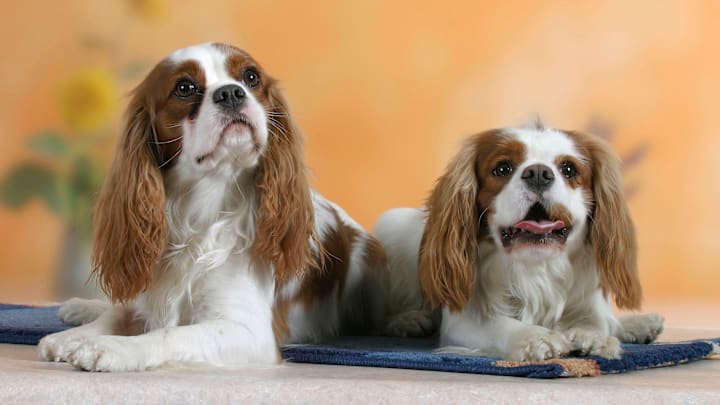With their flowing fur and soft brown eyes, it’s hard to resist the charm of the Cavalier King Charles spaniel.
1. The Cavalier King Charles spaniel was bred from toy spaniels.
The Cavalier King Charles spaniel is itself a fairly new breed, although its predecessor, the toy spaniel, was incredibly popular from the 16th to the 18th centuries. These small lap dogs were brought from France to Scotland in the 1500s by the Queen of Scots. There, they warmed the laps of royalty and cuddled in the beds of queens. These dogs were occasionally featured next to their royal owners in paintings by some of the greatest artists of the time, including Titian, Van Dyck, and Lely.
2. King Charles II gave the breed its name.

The dogs get their name from King Charles II, who was very fond of the dogs. It was said that the king would not go anywhere without at least three spaniels at his heels. The love was so strong that some even accused the king of neglecting his kingdom in favor of taking care of the dogs. He was known as the Cavalier King, which is where the breed gets the other part of its name.
3. According to urban legend, Cavalier King Charles spaniels had access to some high-security places.
It’s said that King Charles II loved his dogs so much that he decreed that the dogs could not be denied entrance to any building, not even the Houses of Parliament. However, that’s just an enduring myth—there isn't any definitive proof that such a law actually existed.
4. The pug influenced the Cavalier King Charles spaniel’s look.
After King Charles II died in 1685, the popularity of the breed began to fade, and other dogs like the pug stepped into the spotlight. The King Charles spaniel was bred with these dogs, giving it a shorter snout and domed head. These features continue to live on in today’s King Charles spaniel, which is a different breed from the Cavalier King Charles Spaniel.
5. The breed was split in two.
By the 1920s, King Charles spaniels had domed heads and short stubby snouts. While these traits were desirable for some, American fancier Roswell Eldridge longed for the spaniels depicted in paintings with King Charles II. He traveled to England and offered 25 pounds for the best examples of “old type” spaniels—ideally larger dogs with longer, more elegant snouts.
Breeders were not interested in rising to the challenge, as they had spent a long time perfecting the short-nosed version. (The first few breeders that did make the attempt were ridiculed.) Eventually, however, interest grew, and a small core group of breeders took up the challenge. The newly created variation was dubbed the Cavalier King Charles spaniel to differentiate it from its puggier peers. Unfortunately, Eldridge did not live to see the results of his project—he passed away in 1928. The first Cavalier King Charles Spaniel club started the same year, with a dog named Ann’s Son as the leading example.
6. Cavalier King Charles spaniels were flea magnets.
Called comfort dogs, Cavalier King Charles spaniels were often brought into beds. They were meant to attract fleas and be bitten instead of their owners, thus saving their humans from the plague or other diseases.
7. Ronald Reagan had a Cavalier King Charles spaniel.

In 1985, President Ronald Reagan gave his wife a Cavie named Rex for Christmas. Rex’s first job as first dog was to turn on the Christmas lights with his paw. He lived a decadent lifestyle, complete with a fancy doghouse designed by Theo Hayes, great-great-grandson of President Rutherford Hayes. Inside, there were red drapes and framed pictures of his owners hung on the walls. When Reagan left office, Rex was presented with a new doghouse shaped like the White House and lined with carpet from Camp David.
8. The breed’s different colors have special names.
Cavies come in four different colors, and they all have unique names. The monikers are: Prince Charles (tri-color), King Charles (black and tan), Ruby (mahogany), and Blenheim (chestnut and white).
9. Blenheim is a reference to a battle.
In the early 1800s, the Duke of Marlborough loved the dogs and kept a number of them with chestnut and white markings. Legend has it that when the duke went off to fight in the battle of Blenheim, his wife stayed home taking care of a spaniel giving birth. To soothe both the dog and herself, the duke’s wife would press her thumb against the dog’s forehead. News arrived that the battle had been won and soon after, the puppies were born with red spots on their heads. This was, of course, just a coincidence, but many believed the marks came from the pressure of the duchess’ thumb. As a result, the coloration, called the “Blenheim spot,“ was named after the battle. The family continued to breed Blenheim dogs until the early 1900s.
A version of this story originally ran in 2015; it has been updated for 2022.
